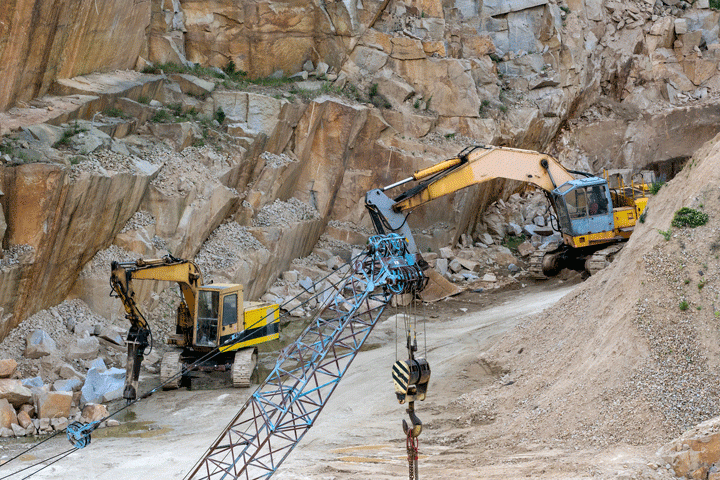The Covert Gems: Exploring Granite Quarries in South Africa
The Covert Gems: Exploring Granite Quarries in South Africa
Blog Article
Discovering the Rich Background and Lasting Practices of Granite Quarrying
As we base on the precipice of uncovering the complex tapestry of granite quarrying, a trip through time reveals not just the physical act of removing stone but additionally the cultural and historic relevance woven into the extremely fabric of this method. From the old beginnings that laid the structure for contemporary quarrying techniques to the sustainable practices that are shaping the future of this sector, each chisel mark on granite surfaces narrates waiting to be discovered (granite quarries in south africa). The heritage of granite quarrying extends far past simple extraction; it is a testimony to human resourcefulness, strength, and the long-lasting appeal of this marvelous stone
Old Origins of Granite Quarrying
Going back to ancient worlds, the method of quarrying granite has been an integral part of human history and building development. The earliest proof of granite quarrying dates back to ancient Egypt, where massive pyramids and detailed sculptures were crafted from this long lasting stone. The Egyptians made use of primitive tools to extract granite blocks from quarries, showcasing the value of this product in their monumental buildings.
Progressing in history, the Greeks likewise made substantial contributions to the quarrying of granite. The Greeks used granite in different building wonders, such as temples and sculptures, showing their skill in shaping and carving this durable stone. The Romans further improved the techniques of quarrying granite, utilizing advanced devices like knives and hammers to essence and shape granite for their iconic frameworks.
With the centuries, the technique of quarrying granite has actually evolved, with contemporary technologies boosting efficiency while maintaining the ageless charm of this all-natural rock - granite quarries in south africa. From old civilizations to contemporary building contractors, the legacy of granite quarrying proceeds to shape our world
Evolution of Quarrying Techniques
The evolution of quarrying techniques has been marked by a continuous progression towards better performance and precision in removing granite. Early quarrying methods included hands-on labor with fundamental tools such as chisels, hammers, and wedges to remove granite blocks from the planet.
In even more recent times, the advent of equipment changed the quarrying market, allowing much faster removal rates and enhanced efficiency. Technologies such as ruby cord saws, high-pressure water jets, and pneumatic drills have actually come to be basic in modern-day quarries, allowing for exact cutting and minimized waste. Innovations in computer-controlled devices and 3D modeling have actually optimized quarrying operations, leading to marginal environmental influence and improved sustainability practices. As the need for granite proceeds to rise, the development of quarrying methods continues to be essential to meeting market requires successfully and sustainably.
Cultural Importance of Granite
Granite holds a profound social relevance across numerous civilizations as a result of its long-lasting presence in architectural work of arts and prized monoliths. From the impressive pyramids of Egypt to the detailed carvings of the Angkor Wat temple in Cambodia, granite has actually been a product of option for expressing magnificence and long life in social heritage. In ancient Rome, granite columns decorated temples and public structures, signifying stamina and durability. The social importance of granite prolongs beyond its physical features; it symbolizes strength, security, and eternity, making it a sign of withstanding heritages and customs.

Sustainable Practices in Quarrying
In the middle of the abundant history of granite try this quarrying and its cultural relevance exists an expanding focus on lasting methods within the sector. As ecological understanding and concerns regarding resource exhaustion have enhanced globally, the quarrying industry has significantly welcomed lasting methods to reduce its effect on the environment and bordering areas.

Moreover, reclamation and rehabilitation of quarry websites post-extraction are integral to sustainable methods. By restoring quarried areas to an all-natural or valuable state, such as creating wildlife environments or leisure rooms, quarriers can offset the ecological impact of their operations and contribute favorably to the neighborhood ecological community.
Heritage of Granite Quarrying
With a historical backdrop soaked in craftsmanship and industrial progression, what withstanding impact has granite quarrying left on the landscape of modern culture? The heritage of granite quarrying transcends simple extraction methods; it has actually shaped architectural wonders, urban landscapes, and cultural heritage worldwide. The long lasting nature of granite has made it a recommended choice for monuments, buildings, and facilities, standing as a testimony to the skill and creativity of quarry workers throughout generations.
Additionally, the economic impact of granite quarrying can not be neglected. The industry remains to give work chances and drive neighborhood economic climates in regions where granite removal is widespread. It has likewise spurred technical advancements in quarrying methods and devices, leading to more efficient and lasting techniques.
In regards to sustainability, the legacy of granite quarrying consists of efforts to reduce ecological effects via reclamation tasks and liable resource monitoring. By stabilizing financial rate of interests with environmental stewardship, the industry makes every effort to guarantee that future generations can remain to gain from this long-lasting natural deposit.
Final Thought

Report this page